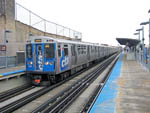|
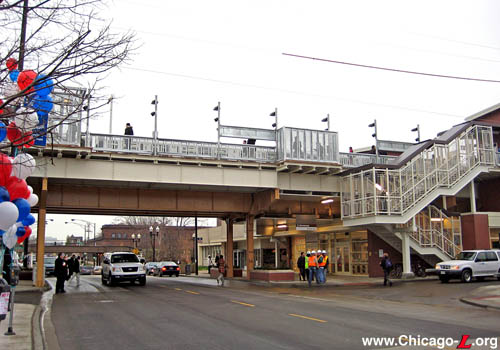
The exterior of the
renovated Montrose station is seen looking southeast on
November 26, 2007. The stairways on the sides and front of
the station house are a prominent feature of the facility's
street elevation. For an larger view, click here.
(Photo by Graham
Garfield)
|
Montrose
(4400N/1800W)
Montrose Avenue and
Ravenswood Avenue, Ravenswood
Service
Notes:

|
Brown Line:
Ravenswood
|

|
Accessible
Station
|
Quick Facts:
Address: 1814 W. Montrose
Avenue
Established: May 18, 1907
Original Line: Northwestern Elevated Railroad, Ravenswood
branch
Previous Names: none
|
Skip-Stop Type:
|

|
Station
(1949-1973)
|

|
Station
(1973-1995)
|
Rebuilt: 2006-07
Status: In Use
History:
Montrose opened with the initial construction of the Ravenswood
branch of the Northwestern Elevated, which was placed into
service May 18, 1907. The station was designed in 1905-06 by the
Northwestern Elevated's Engineering Office and overseen by Chief
Engineer C.M. Mock and Consulting Engineer Charles Weston. The
station was built by the Angus Brothers construction company.
|
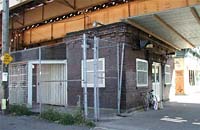
An exterior view of Montrose
station, looking northeast on October 8, 2002. Montrose
station was well intact architecturally and typical of the
1906-07 Ravenswood branch stations between Southport and
Damen. Note the largely smooth brickwork with simple brick
ornamentation around the cornice, belt rail, and in the hood
over the front entrance. For an enlarged view, click
here.
(Photo by Graham
Garfield)
|
The station house measured approximately 25 feet by 25 feet -- a
modest size and scale, relating to its role as a modest neighborhood
station -- and, when viewed in plan layout, was shaped like a
bow-tie. Passengers entered through the front doors and could exit
through the building as well, but ancillary exits were also available
along the sides of the building's exterior. The building narrowed in
the middle to provide space for a exit-only rotogate on each side of
the exterior, which passengers could exit through without entering
the building. The inclusion of such egress was a result of experience
with earlier stations, at which circulation could become congested
when passengers tried to enter and exit through the same confined
space simultaneously. In later years, the west rotogate was removed
and that side passage closed. The east rotogate and side passage
remained in use until the station was demolished and rebuilt.
The building's exterior was constructed of dark red brick and had
a fairly simple design. The foundation was built of stone and
concrete. The exterior walls were largely unadorned, except for
simple ornamentation around the cornice, belt rail, and in the hood
over the front entrance, all of which were executed in the same brick
as the rest of the exterior. The doors originally had multi-pane
windows, later removed.
The interior of the station was similarly modest. The interior
walls were clad in glazed brick and had paving brick flooring. A
large, bracketed, heavy wood beam ran across the width of the
interior in the center, relating a Craftsman influence to the simple
design. As built, there were two open areas on either side of the
doors at the front for circulation and concessions. The interior then
narrowed into the fare control array (due to the aforementioned
rotogates along the exterior), which originally consisted of an
agent's booth in the center flanked by turnstiles on one side and a
heating stove on the other. The original ticket agent's booth was
removed in the mid-1990s when the electronic farecard turnstiles were
installed, replaced by a new booth on the west wall.
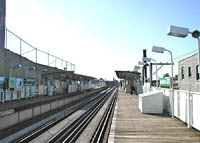
Montrose station's
platforms, looking south on October 8, 2002, were typical of
those on the Ravenswood branch elevated stations. Montrose
had a lot of its original platform materials intact until
its closure in 2006 for renovation, including the typical
Ravenswood canopies, and the platform railings with
sunflower rosettes. For an enlarged view, click
here.
(Photo by Graham
Garfield)
|
After exiting through the station house's rear doors, passengers
walked down an enclosed passageway to access the stairs to the
platforms. The passageway featured full-height grillework consisting
of bars arranged in a geometric Craftsman pattern punctuated by
ornamental cast iron rosettes and an arched galvanized iron roof.
Originally, there was a full-height grille down the center of the
passageway, meaning passengers had to exit through a specific rear
door to access their desired platform, or they would have to reenter
the station house to switch to the other side. Most of the center
panels were later removed to allow access to either platform from the
passageway. The decorative grillework was carried up the stairways to
the platforms.
Montrose featured dual side platforms, constructed of a wood deck
on a steel frame. The platforms featured canopies in the center,
covering the stairs from street-level. The canopies, which were
typical of the 1907 Ravenswood
branch stations, featured a gently arched roof with curved
support columns and latticed framing. The platform railings consisted
of cast iron posts supporting thin metal bars and ornamental
sunflower rosettes in a geometric design alternating with flat
panels, topped with an oak handrail. The canopy design would be
reused first on the Chicago & Oak Park Elevated (also owned by
Charles Yerkes) before becoming the standard for the "L" under the
Chicago Elevated Railroads and Chicago Rapid Transit. The railing
design was also reused elsewhere on the system, most notably at
Clinton/Lake where it was duplicated
almost exactly.
Montrose became an "AB" station under the skip-stop
express system instituted on August 1, 1949, but became a "B"
station on September 2, 1973 when Paulina
closed and Addison became an "A"
station, thus balancing the skip-stop service levels. The station
reverted to an all-stop when A/B
service was discontinued in 1995.
Montrose station retained much of its original material until it
was renovated in 2006-07. In addition to the original station house
and canopies, a great deal of the original platform railings were
also intact from the north ends of the platforms (including the
original curved end pieces) to approximately over the centerline of
Montrose Avenue. The platform extensions at the south end , added
later, had simple, modern metal railings.
Brown
Line Capacity Expansion Project
By 2004, ridership had exploded on the Brown
Line -- an 79% increase since 1979 and a 27% increase since 1998
-- that during peak periods many trains were at crush-loaded,
resulting in commuters left standing on platforms unable to board the
loaded trains, sometimes waiting as one or two trains passed before
they were physically able to board. The problem in large part was
that all Brown Line stations could only accommodate six-car trains
(with the exception of Merchandise
Mart, Chicago, Fullerton
and Belmont, which could already hold
eight-car trains), which, along with the limitations of the cab
signal system, limited the line's capacity.
As a result, the CTA decided to plan for the Brown
Line Capacity Expansion Project, the largest capital improvement
project undertaken by the CTA at the time (surpassing even the Douglas
Renovation Project, which was the largest up to that point). The
main objectives of the Brown Line Capacity Expansion Project are to
expand the line's overall ridership capacity by lengthening station
platforms to accommodate eight rather than six-car trains,
rehabilitate rail infrastructure and stations, provide for station
enhancements to meet the accessibility requirements of the Americans
with Disabilities Act (ADA), and upgrade or replace traction power,
signal and communication equipment. By far, the largest part of the
Brown Line
Capacity Expansion Project was the station renovations. Of the
Brown Line's 19 stations, only one (Merchandise
Mart) was not touched at all due to its modern construction
(1988) and ability to berth eight-car trains.
On April 13, 2004, the CTA announced that it had officially received a Full Funding Grant
Agreement (FFGA) from the Federal
Transit Administration (FTA). However, in May 2004,
CTA received construction bids
for the project that substantially exceeded the budget. As such, the
Chicago Transit Board voted on June 9, 2004 to reorganize the project
into several discrete pieces to help attract more competitive
construction bids. Station renovation work was modified and grouped
into five separate packages according to location to help reduce the
overall cost of station construction. Montrose station was grouped
with Damen, Irving
Park, and Addison in a bid
package, all of which were designed by the same consultant, Earth
Tech, Inc. Station designs were also revised to reduce costs.
Most changes concentrated on non-customer areas such as reducing the
size of janitor closets, employee restrooms, electrical rooms and
communication rooms. Other areas that were studied for cost reduction
were standardizing common station elements, the use of less expensive
materials, canopy designs and coverage, and temporary station
closures to provide contractors better access to the sites.
The Damen/Montrose/Irving
Park/Addison contract was the
fourth of the reorganized station packages to be bid out. At the July
20, 2006 board meeting, a $58 million contract for the renovation of
these stations was awarded to James
McHugh Construction.
Following contract approval, the construction contractor prepared
and submitted a construction plan to
CTA for approval.
CTA held a community meeting
to provide further construction details and timelines for the
work.
Station Design
The contract included construction of a new, modern station house,
extension of the platforms to accommodate 8-car trains, and
installation of elevators for ADA accessibility. The new expanded
station facility featured an increased number of turnstiles and
farecard vending machines.
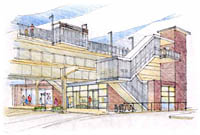
Artist's rendering of the
design for the renovated Montrose station. A new masonry
station house with a glass front facade was built across the
street from the 1907 entrance. For a larger view, click
here.
(Image provided courtesy of
the Chicago Transit Authority)
|
The new station house is located on the south side of Montrose
Avenue, the opposite side of the street as the original 1907 station
house. The station house is clad in glazed brick with metal coping
along the top. The front of the station house features a glass
storefront framed by aluminum mullions. A dual set of double doors
are divided by a central window bay with a concrete planter in front,
framed on each side by window bays with thin sans-serif lettering
spelling "MONTROSE" divided
on two lines, and topped by transoms. A shallow cantilevered canopy
covers the front elevation. The dual elevator towers are clad in
glazed brick and feature distinct sloped roofs.
The interior has a largely open plan. A Customer Assistant booth
is located in the middle of the interior on the west side and a
stainless steel concession booth is located on the east side, with a
row of turnstiles between the two separating the unpaid and paid
areas. The farecard vending machines are located on the west wall.
The walls are clad in white square tiles, while the floor is cast
concrete (except under the turnstiles, where it is granite
tiles).
Montrose station features original artwork depicting the street
names within the community. Affixed to the rear (south) wall in the
station house's paid area, the artwork was created by artist Jason
Pickleman. To foster a sense of ownership and identity within each
station and the surrounding community, the
CTA partnered with the
City
of Chicago's Department of Cultural Affairs to install public art
at all 18 renovated Brown
Line stations. Public art for each station in the project was a
requirement of the Full Funding Grant Agreement and is part of the
overall project budget.
A set of stairs and an elevator provide access from the paid area
to each platform. Unlike most stations, whose stairs to their
platforms are largely hidden behind their station houses, Montrose's
are to the sides and project toward the street rather than away from
it as they ascend upward. At the first landing the stairways turn,
with a 180-degree switchback, before reaching the platform. As a
result, the stairways are a dominant feature of the station facility
when viewed from the street. The stairways to the platforms are
enclosed in a white-painted steel grille system of thin bars
punctuated by ornamental sunflower rosettes divided by a heavy
tubular steel framework. Although the design of the grilles are meant
to evoke the original station's railings and stairway grilles, they
are new construction. The rosettes, however, are reused from the
original facility.
The dual platforms were renovated with new decking, railings,
lighting, signage, and other fixtures. The existing original canopies
were retained and refurbished, stripped of decades of paint,
repainted dark brown, and topped with new corrugated metal arched
roofs. The new railings are a standard design for the rebuilt
Brown Line elevated
stations, with thick tubular top and bottom horizontal members with
rectangular panels with a grid pattern cut out. The railings and
light poles, as well as the other new metalwork, are hot-dipped
galvanized. The light poles are integrated into the railing posts.
The platforms are finished with windbreaks integrated into the
railing system -- some of which are cantilevered out over the street,
so as not to reduced the width of the platform at those locations --
with the glass panels protected by metal grilles matching the
railings. New benches with sandboxes integrated into them dot the
platform, posts with projecting horizontal arms for A/V signs (to be
installed later) are suspended over the platforms, and Transit
Information panels are posted at the tops of the stairs.
Auxiliary exits are provided on the north side of Montrose Avenue.
The auxiliary exit stairs are located under the original canopies
(which remained in the original locations) and are enclosed by the
same decorative white-painted metal grilles as the stairs from the
station house. The stairs from each platform descend into a common
landing, located on the former site of the 1907 station house, with
egress provided by a pair of stainless steel exit rotogates
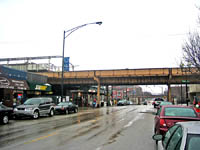
The former location of
Montrose station, under reconstruction, is seen looking east
on December 31, 2006. Note that the platforms over the
street has been demolished and the canopies have been
striped down to the bare structure for refurbishment. For a
larger view, click here.
(Photo by Graham
Garfield)
|
Other improvements include new signage; new electrical,
communications, and HVAC equipment; customer heaters on the
platforms; security cameras; and a state-of-the-art announcement
system.
Station Renovation Work
Montrose station closed at 3am, Saturday, December 2, 2006 for
renovation, the same day as Addison
station two stops south. The station temporarily closed for just
under 12 months while construction crews worked to extend the
platforms, rebuild the station house and make the station accessible
to customers with disabilities. Consistent with the
CTA's pledge that no two
consecutive stations would be closed at the same time on weekdays,
the adjacent stations -- Damen and
Irving Park -- remained open
during Montrose's temporary closure so customers could continue to
access Brown Line
service. In addition to the neighboring stations, alternate service
was also available from several area bus routes.
Work at Montrose began almost immediately after the station
closed. During December 2006, the station house and platform decking
were completely demolished. Many of the platform stringers were also
removed for replacement. The platform canopies were also
disassembled, with the roofing removed and the structure stripped
down to the frame. During winter, the southbound canopy was
refurbished and primed; however, the northbound canopy had not yet
been reinstalled.
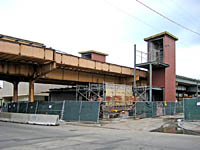
Its steel frame in place,
the brick and tile facing is being applied to the new
Montrose station in this view looking southeast on July 27,
2007. For a larger view, click here. (Photo by Graham
Garfield) |
Work continued into spring 2007 on refurbishing the existing
elevated structure columns and footings, as well as the existing
platform and canopy steel. Installation of the steel framing for the
platform also began. During May 2007, work began on the foundations
for the new station house and auxiliary exit.
In June, crews began erecting the steel frame for the new station
house. The steel frames for the new elevator towers were also
installed during this period. By July, the steel framework was in
place and work began on the masonry cladding on the station house and
elevator towers. After the structures for the station house and
elevator towers were in place, erection of the remaining platform
stringers was completed.
During July, installation of the platform wood decking and steel
railings commenced. In mid-July, temporary barricades were installed
along the platforms, protecting the construction workers and allowing
them to work without interfering with passing trains. During summer,
work continued on the platforms, as well as on the installation of
elevator equipment.
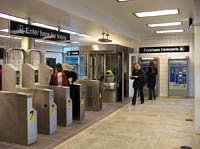
The interior of the
new Montrose station, with its Brown Line-standard
CA booth and white tile walls, is seen looking west
in the unpaid area on November 26, 2007. For a
larger view, click here. (Photo by Graham
Garfield) |
Station house build-out continued through summer and into Fall
2007. Work included installation of masonry walls, plumbing,
electrical systems, and HVAC systems. During the same period, work
also continued on installing platform decking, railings, light poles,
and other fittings. In late summer, the new stairs from the station
house to each platform were installed.
Installation of elevator equipment continued into Fall, as did
railing installation and refurbishment of the original platform
canopies. By Fall, the structure of the northbound canopy had been
reassembled back in its original location. By October, most of the
station's structure was complete. The station house's and elevator
towers' brick cladding was completed and the station house's metal
and glass panels were installed. The steel for the stairs and
landings was in place and the railings and light poles were nearly
complete. During October and November, the platform light fixtures
and speakers were installed. During Fall, the new steelwork was
painted.
Contractor crews spent late Fall 2007 finishing the details
of the new facility. Raised concrete and glazed brick
planters were installed outside the station house and
auxiliary exit along the street, under the elevated
structure. Other items installed during this period also
included a compass rose on the sidewalk in front of the
station entrance, bike racks under the stairs on both sides
of the station house, and new signage throughout the station
facility.
Montrose station reopened at 4am, Monday, November 26,
2007, six days before the one-year deadline from the date of
closure. CTA President Ron Huberman, Congressman Rahm Emanuel, and 47th
Ward Alderman Eugene Schulter gathered at the Montrose
station to mark the reopening of the station at a press
conference at 10am that day. With the new elevators in
operation on opening day, Montrose became the 79th of the
CTA's 144 station to
become accessible, with other ADA-compliant features
including an accessible turnstile, tactile platform edging,
gap fillers, TTY telephones and Braille signs.
At the same time Montrose reopened, the Damen station closed for renovations for up to one year. Modest
work continued at Montrose station after the reopening, as
the contractor completed various punchlist work.
The Brown
Line Capacity Expansion Project Full Funding Grant
Agreement with the federal government requires that the
CTA complete the
entire project by the end of 2009.
|
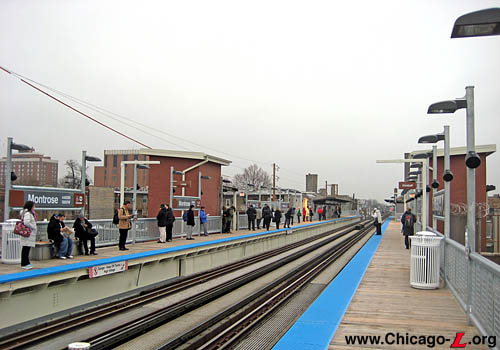
Montrose station's renovated
dual side platforms, with their Brown Line-standard
galvanized steel railings and flanked by sloped-roof
elevator towers, are seen looking north on November 26,
2007. For a larger view, click here.
(Photo by Graham
Garfield)
|
 Old Montrose
(1907-2006) |
New Montrose
(2006-present)
Old Montrose
(1907-2006) |
New Montrose
(2006-present)
Old Montrose station
(1907-2006)

|
cta4377a.jpg
(126k)
The CTA's training train is on the Ravenswood here, passing
Montrose station on August 20, 1970. Note the two uniformed
men in the motorcab; presumably, one is the line instructor
or supervisor and the other is the trainee.
(Photo by Joe Testagrose)
|
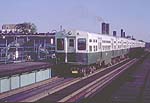
|
cta6029.jpg
(115k)
6000-series car
6029 leads a 6-car Ravenswood "B" train at Montrose on
August 21, 1970. Note the several early A/B symbol signs on
the light posts. (Photo by Joe
Testagrose)
|
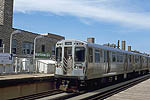
|
cta3437b.jpg
(83k)
Car 3437 fronts a Loop-bound Brown Line train pulling into
Montrose station, looking northwest from the northbound
platform on July 16, 2000.
(Photo by Mike Farrell)
|
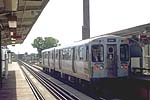
|
cta3438.jpg
(70k)
Car 3438 brings up the rear of a two-car off-peak
Brown Line train stopping Montrose on July 16, 2001.
(Photo by Mike Farrell)
|
|
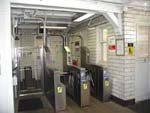
|
montrose02.jpg
(224k)
The interior of Montrose station on October 8, 2002,
with its glazed brick walls and Craftsman-inspired wood
beams. (Photo by Graham Garfield)
|
New Montrose
station
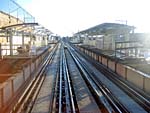
|
montrose05.jpg
(181k)
The Montrose platforms are seen after closure of the station
for renovation, looking south in December 22, 2006. Less
than a month after closure, large portions of the wood
decking have been removed and the canopy roofing is also
beginning to be dismantled. Sandwich boards on the platform
remind operators not to top their trains at the
station. (Photo by Graham
Garfield)
|
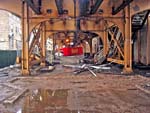
|
montrose06.jpg
(257k)
One month after the station's closure, the Montrose station
house was completely demolished. The only indication that a
station was once there is the outline of the building's
foundation, seen looking north on December 31, 2006. The
stairs to the platform are still in place, soon to be
demolished. (Photo by Graham
Garfield)
|
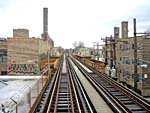
|
montrose08.jpg
(197k)
The Montrose platforms are seen looking south on January 4,
2007. The decking has been removed except in the center
under the canopies, allowing the steel stringers to be
refurbished. (Photo by Graham
Garfield)
|
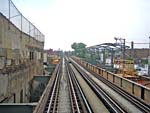
|
montrose09.jpg
(187k)
With the old wood decking and canopy roofing removed, work
is underway to refurbish the steel platform stringers and
canopy structure, looking south on May 23, 2007. The
northbound platform's canopy structure and several sections
of platform stringer were removed and not put back for
several months. (Photo by Graham
Garfield)
|
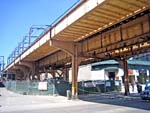
|
montrose10.jpg
(192k)
The former location of the 1907-built station house has been
cleared in this May 27, 2007 view looking north, with the
foundation being installed for the eventual installation of
an auxiliary exit. Some refurbishment on the original steel
structure, such as new flange angles and footings, is
visible. (Photo by Graham
Garfield)
|
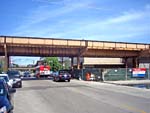
|
montrose11.jpg
(158k)
In this view looking east on May 27, 2007, all evidence of
the old Montrose station has been erased, save for the steel
stringers crossing Montrose Avenue. The new station house
would be erected behind the fencing on the right, where a
foundation is already being laid. (Photo by
Graham Garfield)
|
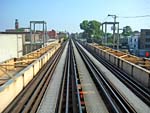
|
montrose12.jpg
(188k)
The steel frames for the dual elevator towers have been
lifted into place in this June 24, 2007 view looking south.
Although some refurbishment of the original platform steel
has taken place, the new steel stringers for the platform
extensions are not yet in place. (Photo by
Graham Garfield)
|
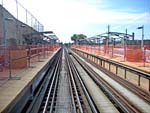
|
montrose14.jpg
(171k)
Renovation of the Montrose station platforms is progressing
in this view looking south on September 16, 2007, with the
canopy structure reassembled and new platform stringers for
the northbound platform. Installation of the galvanized
steel railings and light poles and wood platform decking is
also proceeding. The orange construction fencing allowed
contractors to work on the platform without interfering with
train operations. (Photo by Graham
Garfield)
|
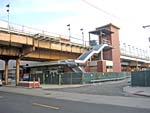
|
montrose15.jpg
(138k)
The station house and elevator towers' brick, metal, and
glass exteriors are largely complete and the steel structure
is in place of the stairs and landings, looking southeast on
October 7, 2007. Many of the platform fittings are also in
place, although some items, like the windbreak cantilevered
off the back of the platform, have yet to be
installed. (Photo by Graham
Garfield)
|
|
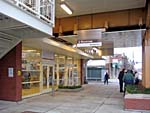
|
montrose17.jpg
(228k)
The new Montrose station house, with its glazed brick sides
and metal frame-and-glass storefront, have been open to the
public only a few hours in this November 26, 2007 view
looking west. The short cantilevered canopy over the
entrance and metal drip-pan over the sidewalk protect
customers from rain and other weather.
(Photo by Graham Garfield)
|
|
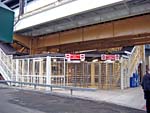
|
montrose18.jpg
(248k)
An auxiliary exit from both platforms stands on the former
site of the original 1907 station house, seen looking
northeast on November 26, 2007. A stair from each platform
leads to be a central landing, protected by decorative
white-painted metal grilles, with access controlled by a
dual set of stainless steel exit rotogates.
(Photo by Graham Garfield)
|
|
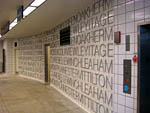
|
montrose20.jpg
(196k)
The back (south) wall of the Montrose station interior
features original artwork created by artist Jason Pickleman,
seen looking east in the paid area on November 26, 2007. The
art installation consists of continuous rows of thin metal
sans-serif letters, which spell the names of streets in the
local neighborhood (without spaces separating
them). (Photo by Graham Garfield)
|
|
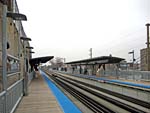
|
montrose22.jpg
(204k)
The renovated platforms at Montrose station are seen looking
south from the north end of the outbound platform on
November 26, 2007. The original 1907 canopies have been
retained and refurbished, kept in their original locations.
They now cover the stairs to the auxiliary exit rather than
the main stairs from the station house. The galvanized steel
railings and light poles are standard for the new elevated
Brown Line
stations. (Photo by Graham
Garfield)
|
|
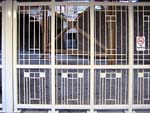
|
montrose23.jpg
(256k)
The full-height metal grilles on the main and auxiliary exit
stairs, as well as the street-level landing at the auxiliary
exit (seen here on November 26, 2007), consist of
white-painted steel grille system of thin bars punctuated by
ornamental sunflower rosettes divided by a heavy tubular
steel framework. Although the design of the grilles are
meant to evoke the original station's railings and stairway
grilles, they are new construction. The rosettes, however,
are reused from the original facility.
(Photo by Graham Garfield)
|
|
cta5009k.jpg (155k)
5000-series prototype car 5009 leads an 8-car Brown Line train heading toward Kimball on December 23, 2010, on an express run and passing through Montrose without stopping. As a result, the train is displaying "Express" destination sign readings and its front marker lights are flashing white-white. (Photo by Graham Garfield) |

- Montrose_Brown-IrvingParkNext.m4a (441k): "This is Montrose." ...
<ding-dong> "Doors closing. Irving Park is next. Doors open on the right at Irving Park. Your safety is important. If you observe unattended packages, vandalism, or suspicious activity, inform CTA personnel immediately." (Sound courtesy of Bailey Rodriguez)






























